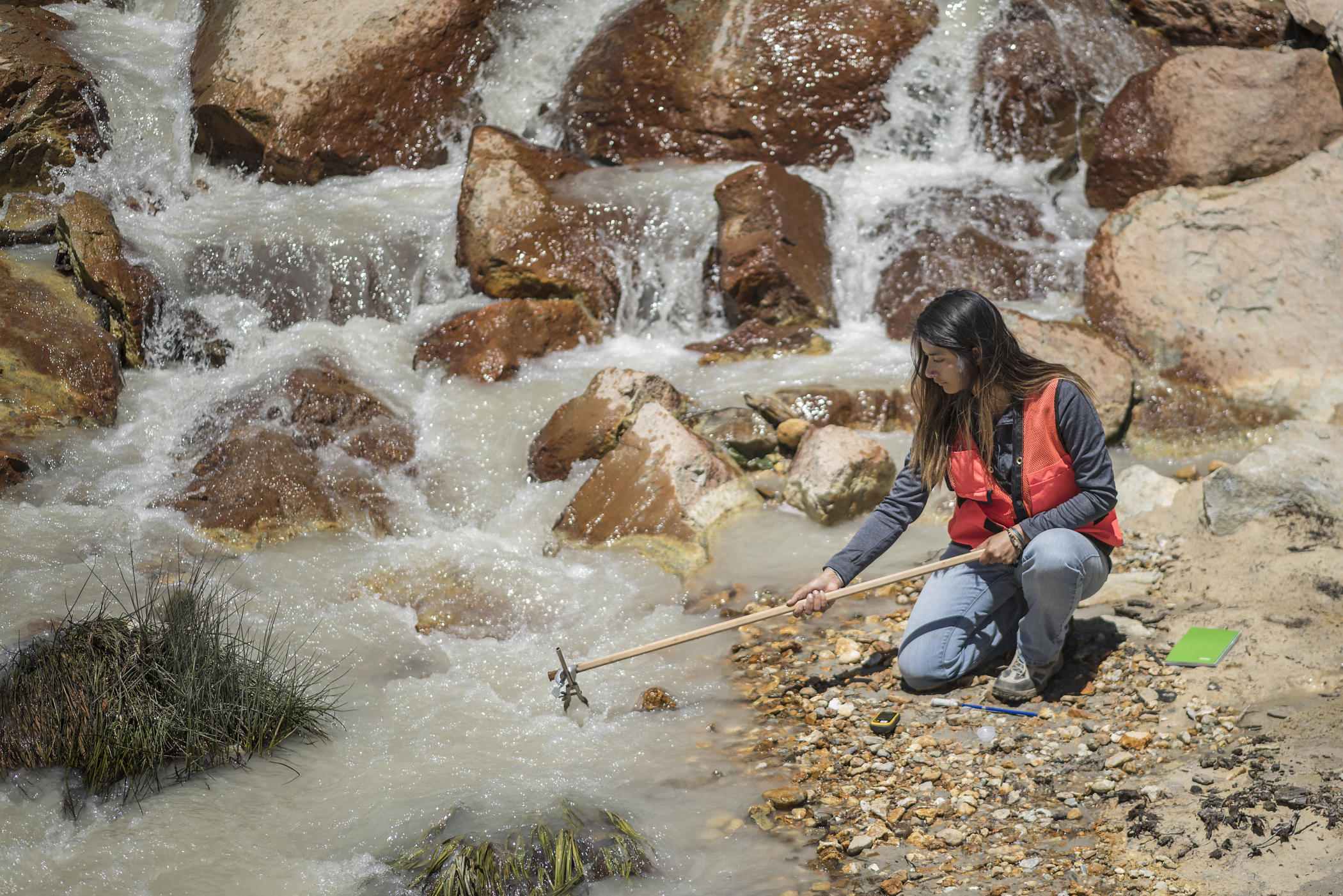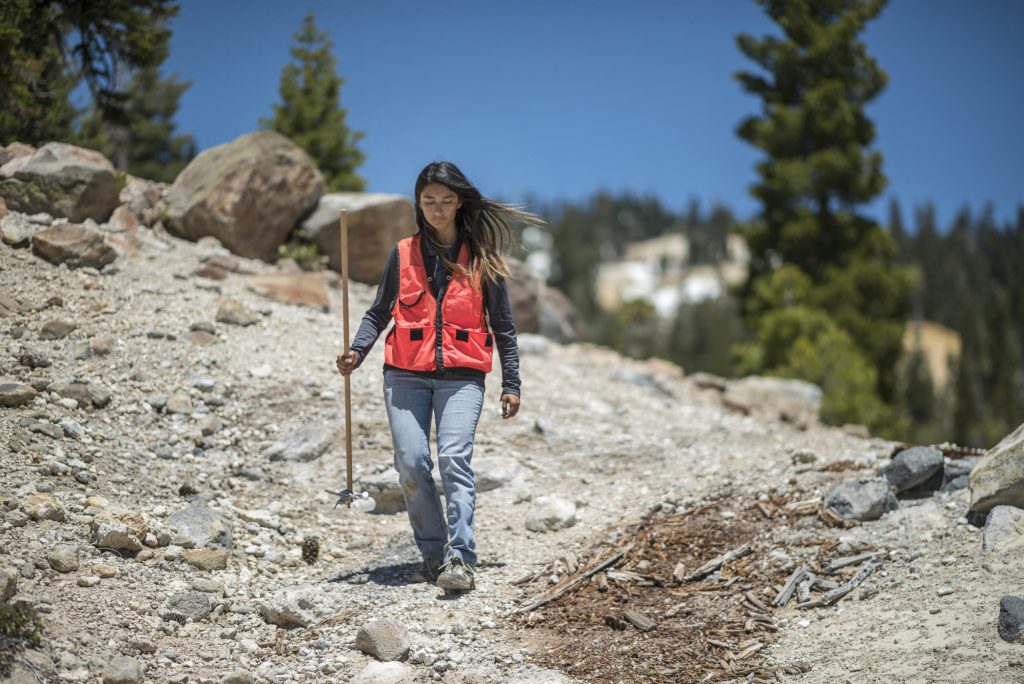Grant Supports Groundbreaking Hydrothermal Research: Student Examines Lassen’s Volcanic Activity Potential

Angelica Rodriguez collects water samples along various stream tributaries to monitor hydrothermal water temperature and composition at the Lassen Volcanic National Park for her Chico STEM Connections Collaborative (CSC2) 2017 summer research project.
Angelica Rodriguez admits she has always been interested in science. When she was a little girl, her older sister told her she would grow out of it. Scared by the prospect, her passion only intensified.
“I literally Googled ‘How to be outdoors and do science all the time,’” she said. “You get to ask a question and maybe you get lucky and you answer it. And when you answer a question in science, it makes you want to ask more.”’
On her own in the otherwise off-limits expanses of Lassen Volcanic National Park, Rodriguez walks across sulfur-tinged soil to pull data near steaming hydrothermal vents and leans carefully over a pool of bubbling mud. The geology major is pursuing a little-studied examination of Lassen’s elaborate and active hydrothermal system. Not only does it provide insight into potential activity within its volcanic system, but the research can be shared with other volcanologists and compared to other systems.
“It’s really amazing, that we can see at the surface what is happening down below,” she said. “I consider the Sulfur Works to be the ancient heart of Mount Tehama.”
With the guidance of volcanology professor Rachel Teasdale, Rodriguez is studying water temperatures, clarity, and other details of the hydrothermal system, using data recorders that take readings every 15 minutes. As the only continuous data collection on hydrothermal systems in the Cascades, the regular readings provide more valuable context than annual or biannual readings that have been done elsewhere.
Originally from Morgan Hill, south of San Jose, Rodriguez started college as an agricultural education major. But she changed to geology within a month.
“You can merge being outside, hiking, and camping with being in the lab. It connects me to myself and what I think are my roots,” she said.
Of all the students who perhaps could have ended up working on a project at Lassen, Rodriguez is a near-perfect fit. She’s been visiting the national park for years after discovering it through Adventure Outings, and she’s been leading the campus program’s hikes and other outings there ever since.
“Angie has really revived this project and gotten the momentum back,” Teasedale said. “It’s the perfect situation where a student is so enthusiastic and excited to learn and so hardworking and independent. It’s really like having a colleague more than a student.”
Perched on the hillside far behind “do not cross” fencing, she cuts the protective layer of garbage bags and flips open her laptop to pull days’ worth of data from her recording device. Once it has been cleared, she snaps it shut and wraps it back up with a few strips of duct tape for good measure, protecting it and her precious data from the elements.
Next, she’s scooping water from the mud pots for a temperature reading. With a bottle clamped at the end of a 4-foot rod, she learns it’s a scalding 173 degrees Fahrenheit.
Rodriguez’s work is made possible thanks to support from the Louis Stokes Alliance for Minority Participation and a portion of a $4.2 million, five-year grant the University received from the US Department of Education. The Hispanic-Serving Institution (HSI) STEM grant supports agriculture, natural sciences, and engineering, computers science, and construction management students who identify as low-income or Hispanic, creating opportunities in the newly established Chico STEM Connections Collaborative program.

“This summer, I wanted to do research no matter what,” she said, noting she applied for jobs near and far that would afford her that opportunity, even if it meant going into debt.
But then, Teasdale suggested she apply for the HSI STEM grant. As a first-generation and Hispanic student, she was a perfect fit for Chico STEM Connections Collaborative, and she embraced the opportunity.
“It’s really hard to find other minorities in geology. But I’ve been in that situation my entire life. I’m Hispanic but my parents worked really hard to do three jobs to have a house in the Bay Area and give us opportunities,” she said. “They are very proud that I’m taking my education into my own hands. It makes me feel resilient, that I’ve taken it upon myself to find these opportunities that otherwise would not have been available to me.”
The grant allowed her to spend all summer doing research at Lassen, as well as invest in new tools for her data collection and fund a trip to an international conference where she could present her preliminary results to professionals.
“That program is all about opportunity. This is launching Angie’s career, making contacts for grad school, opening doors for her to be a professional scientist, whether in academia, where she would be a professor at a university working with students herself or in the US Geological Survey where she continues to do science full time,” said Teasdale.
For Teasdale, who has been at Chico State since 2004, it’s encouraging to see underrepresented students more frequently in the STEM fields and taking an active role, as well as presenting at conferences where they are even further underrepresented.
“That program is all about opportunity. This is launching Angie’s career, making contacts for grad school, opening doors for her to be a professional scientist, whether in academia . . . or in the US Geological Survey where she continues to do science full time,” volcanology professor Rachel Teasdale said.
“Already other students are seeing her as a role model,” Teasdale said. “Her attitude of ‘I did it, and so can you’—those are the messages that all students need, but especially students who have not had access to those kinds of role models or opportunities before.”
Teasdale also noted how grateful she is for the University’s relationship with Lassen Volcanic National Park, which has created the opportunity for hands-on, meaningful research for more than a decade.
Jason Mateljak, the park’s chief of resource management, says the partnership is mutually beneficial. Of more than 141 institutions that have conducted research in Lassen since 2002, Chico State has the second highest number of permitted studies, demonstrating a strong history of collaboration.
“Whether through research into geology, hydrology, pyrogeography, or rare plants, the wide range of opportunities to work with Chico is critical to advancing our mission and research potential,” he said.
As in Rodriguez’s project, University partners provide the park with outside expertise and staff to complete work that could otherwise not be conducted. In turn, Lassen provides faculty and students with a unique, living laboratory and seeks to expand resources to support future research.
“It is essential that parks be open and available to students to advance service-wide goals of engaging the next generation of park stewards, to provide leadership and learning opportunities for talented Chico students, and to facilitate access for students and faculty-led projects,” Mateljak said.


